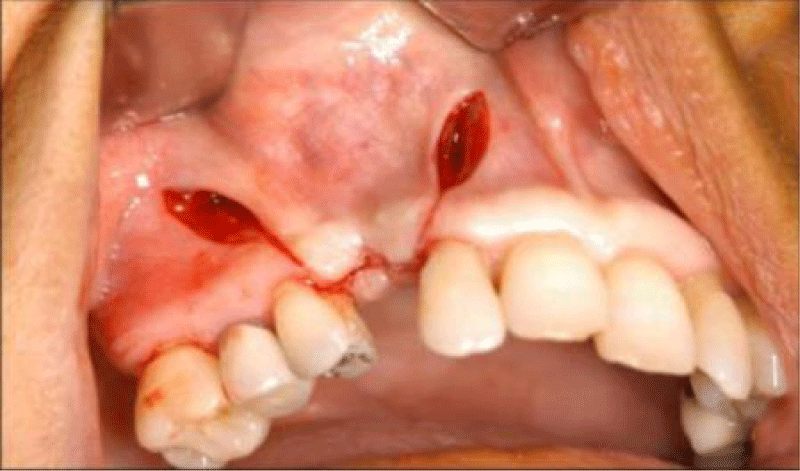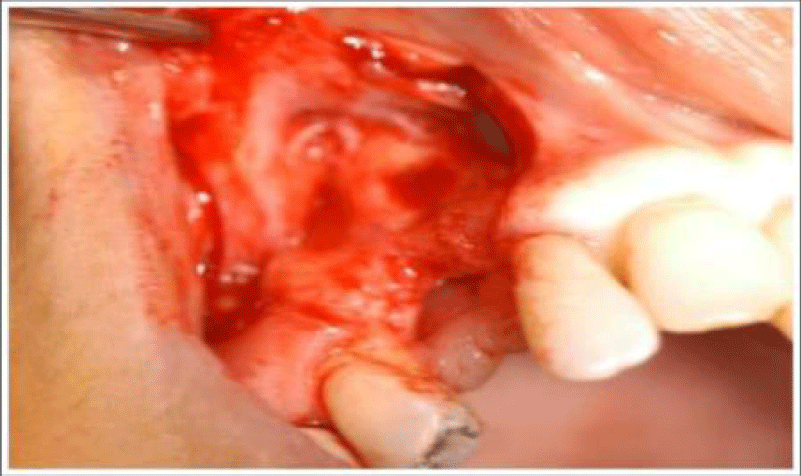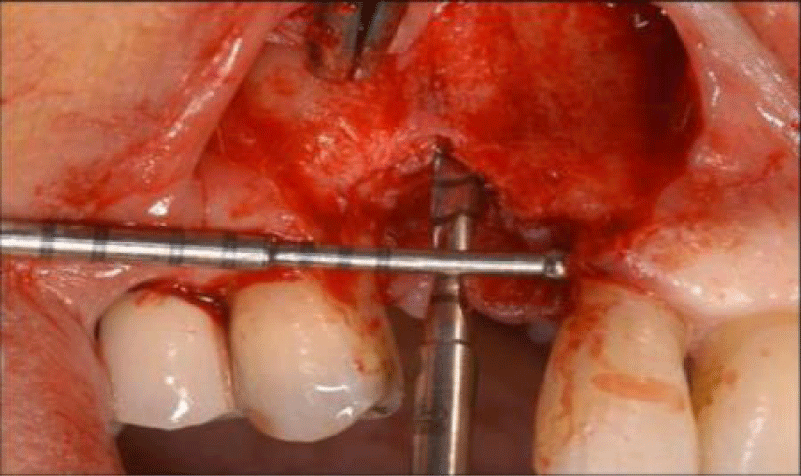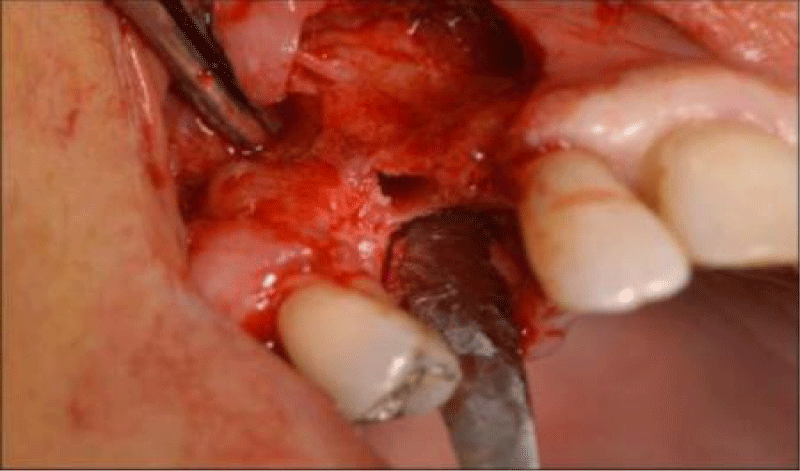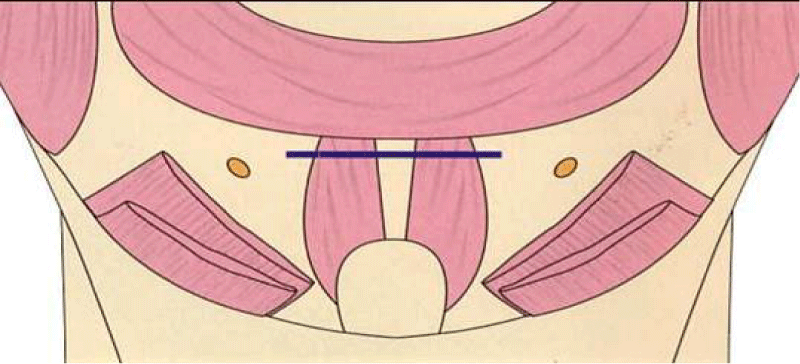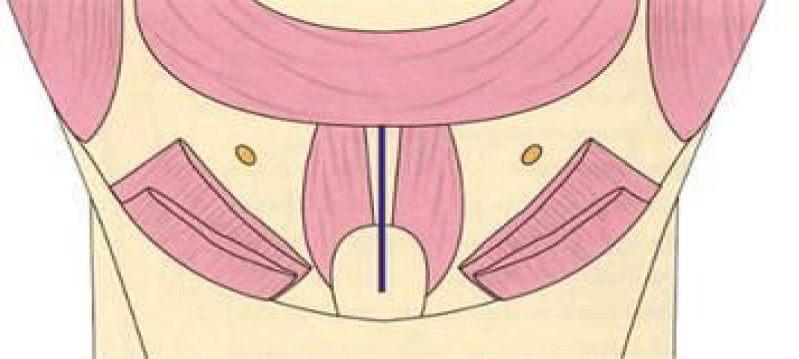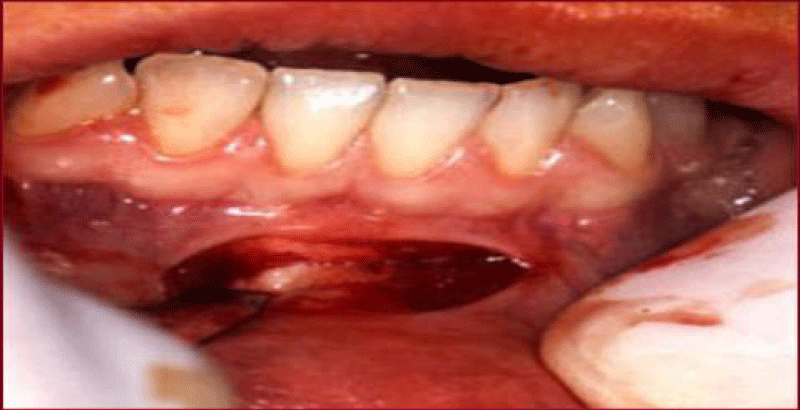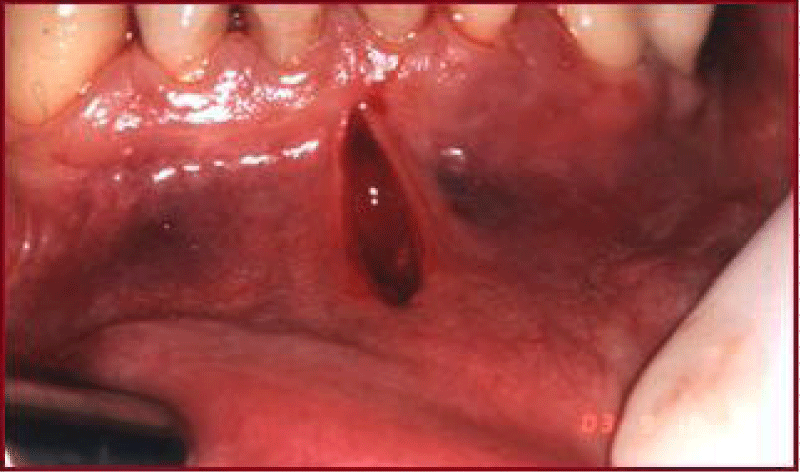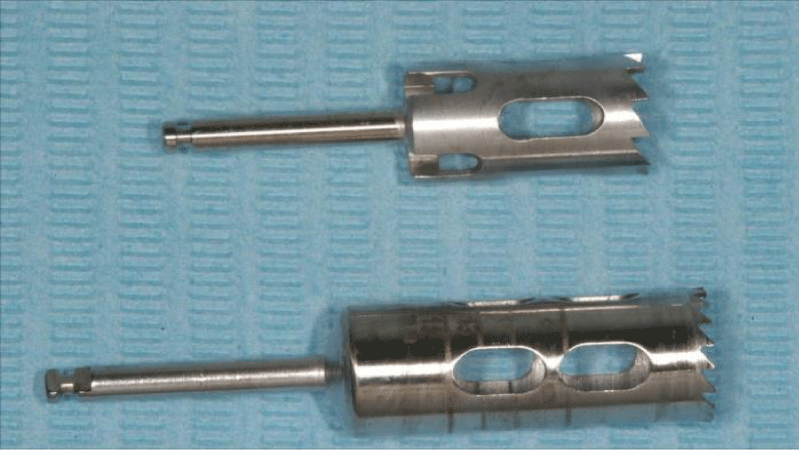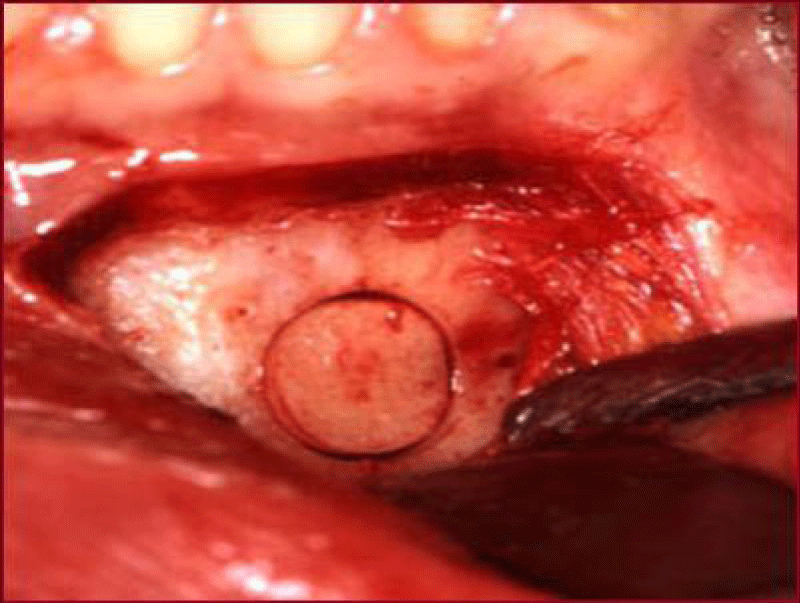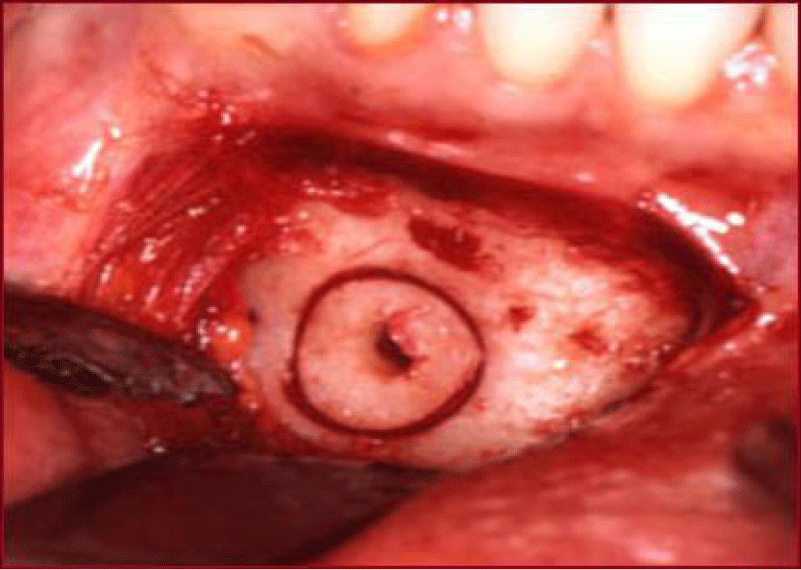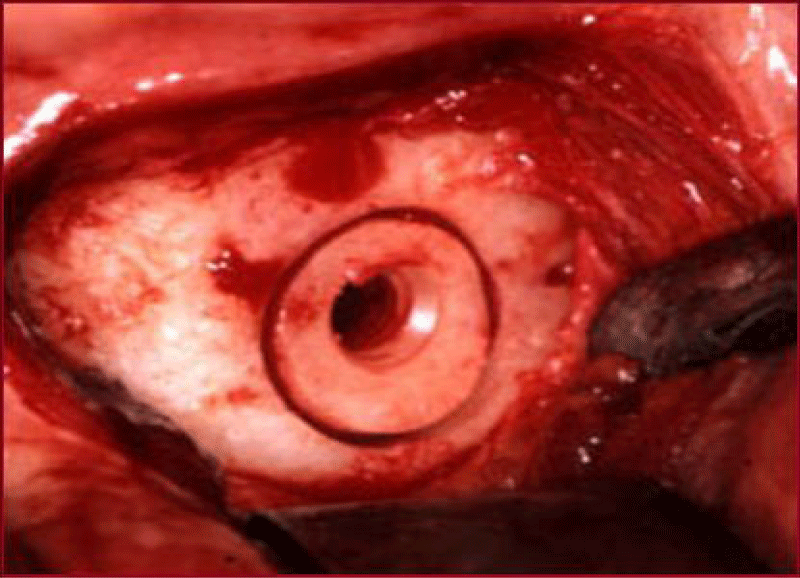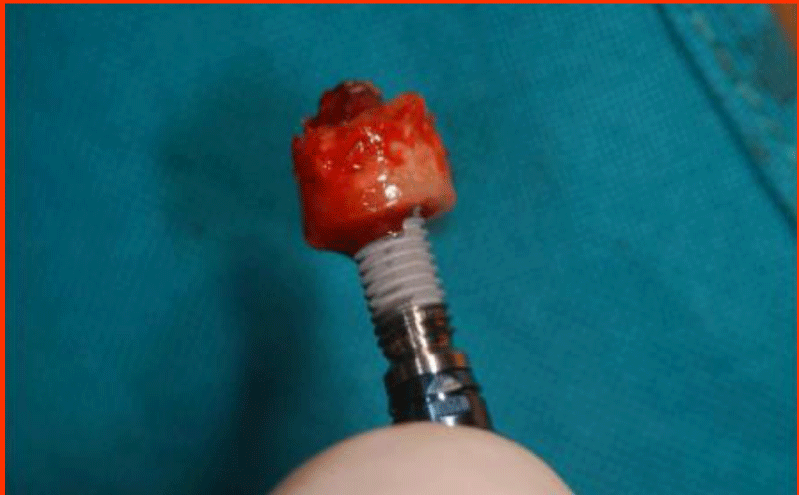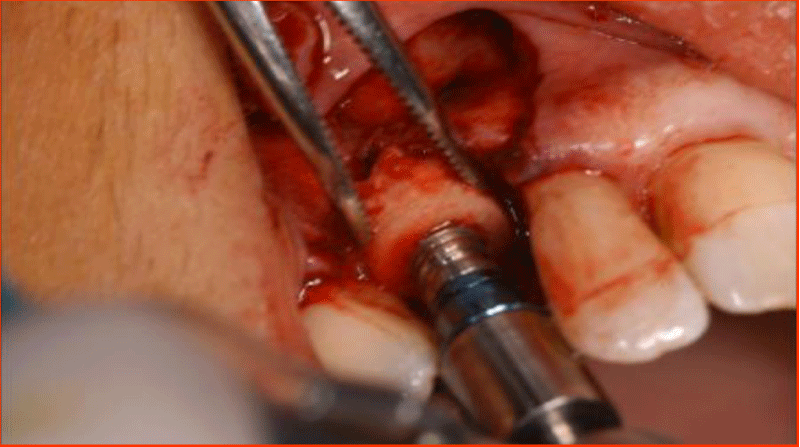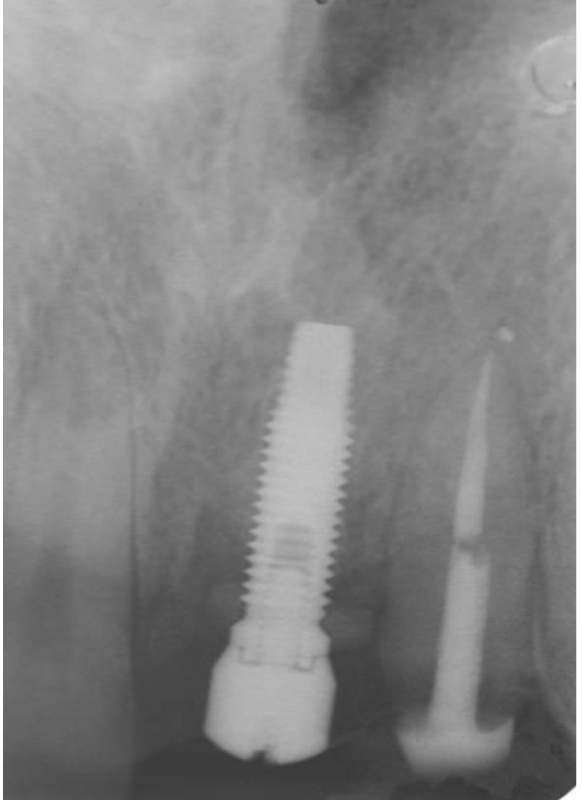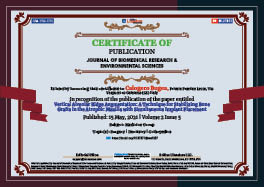> Medicine Group. 2021 May 15;2(5):333-338. doi: 10.37871/jbres1237.
Vertical Alveolar Ridge Augmentation: A Technique for Stabilizing Bone Grafts in the Atrophic Maxilla with Simultaneous Implant Placement
Bartolomeo Lofano1, Roberto Luongo2, Giuseppe Bianco3, Andrea Lofano1, Alessandro Vantaggiato4, Eugenio Pedulla5, Antonio Scarano6, Emanuele Frassanito4 and Calogero Bugea4*
2Private Practice Bari, Italy
3Private Practice Rome, Italy
4Private Practice Lecce, Italy
5Department of General Surgery and Surgical-Medical Specialties, University of Catania - Catania, Italy
6Department of Oral Science, Nano and Biotechnology and CeSi-Met University of Chieti-Pescara
Abstract
Achieving adequate fixation of bone blocks harvested from the mandibular symphysis and used in conjunction with dental implants has been a continuing challenge. In response, the Authors developed a method of using the implant itself to stabilize the graft material in single-implant sites in severely resorbed alveolar ridges. This technique was utilized to place 19 standard implants in 15 patients. After 12 to 60 months of clinical and radiological follow-up, all implants had survived, a success rate of 100%. Measurements of the radiographs showed bone loss of 1.70 mm ± 0.4 mm.
Introduction
Rehabilitating the anterior maxilla with dental implants continues to be a challenge for clinicians. Although the osteointegration of implants has been widely demonstrated, aesthetic results are not always predictably achieved [1,2], particularly when the loss of anterior maxillary alveolar bone due to trauma, anodontia, or periodontitis precludes ideal implant placement.
To optimize prosthetically guided implant placement in the resorbed anterior ridge, an augmentation procedure may be required. The use of a bone block harvested extraorally or guided bone regeneration are both considered predictable techniques for augmenting the height as well as the width of the deficient ridge in completely or partially edentulous patients. Autogenous bone is still considered the gold standard among augmentation materials [3-9].
Although bone from the iliac crest is most often used in major jaw reconstructions, it is not always recommended in implant dentistry due to the morbidity, altered ambulation, and need for hospitalization involved in harvesting it. These disadvantages, together with the fact that dental implant sites do not demand large amounts of bone, have led to the growing use of bone blocks harvested from intraoral sources, especially the mandibular symphysis and ramus [10,19]. Several studies have demonstrated that intraorally harvested intra-membranous bone grafts show less resorption, exhibit enhanced revascularization, and are better incorporated into the donor site, compared to extraorally harvested endochondral bone [7-9].
The principal problem associated with using such grafts in association with dental implants is that of achieving adequate fixation of the graft material during the healing period. Bone screws can be used and removed after sufficient healing has occurred. As an alternative, the authors developed a new technique for stabilizing mandibular bone blocks in single-implant sites in severely resorbed alveolar ridges using the implant itself.
Materials and Methods
This retrospective clinical study involved 15 patients (7 male and 8 female) ranging in age from 22 to 65 (mean = 36) who were treated between November of 2003 and January 2007.
In order to make an appropriate diagnosis, a panorex, a series of periapical radiographs, and a topographic CT scan of the maxillary region were obtained from each individual. All patients had lost one or more maxillary anterior teeth (two from trauma, three due to anodontia, eight as a result of periodontal disease, and two due to caries or prosthetic failures). All exhibited associated horizontal and vertical bone loss.
If the patient had a sufficient mesio-distal edentulous space (at least 7 mm) [7] to accommodate the placement of a standard-diameter implant and a residual vertical ridge of at least 5 mm to enable stabilization of a graft, he or she was given the option of receiving a bone block stabilized by means of the new technique.
Prior to surgery, all sources of inflammation at the recipient site (gingivitis, periodontitis, endodontic infections/lesions, etc.) were eliminated. All patients were treated surgically by two of the authors, who worked with different experienced prosthodontists. A current clinical evaluation and appropriate radiographs were available for all patients.
On the day of surgery, after administration of local anesthesia, a crestal incision was performed in the edentulous area, and a full-thickness flap was raised. The flap was released at the base with a periosteal incision (Figures 1 & 2), in order to later obtain better closure of the soft tissues and better healing of the implants in the grafted bone. A periodontal probe was been used to measure dimensions of the defect (Figure 3).
The implant site was prepared following the manufacturer’s recommended protocol for placement of standard diameter implants (BIOMET 3i, Palm Beach Gardens, Florida) and in accordance with the technique described by Adell, et al. [18] using high-speed drills without countersinking (Figure 4).
In 9 patients the donor site was prepared by creating a vertical flap. In this approach, the incision was created vertically in the midline of the soft tissues of the symphysis, allowing for better healing but providing a smaller view of the donor site
When two block grafts were needed from the chin because the patient would be receiving two implants, the authors preferred to use a horizontal flap (Figure 5). To create it, the incision was placed 10 mm below the mucogingival junction, extending from the distal aspect of both mandibular canines to allow for adequate access and an easier adaptation of the flap for tension-free closure. This approach offered a good view of the donor site, but posed the risk of increased morbidity, due to the presence of the mental muscle; for this reason sometimes it is preferable to use a vertical incision (Figure 6).
In both approaches, a full-thickness flap was elevated, and the remaining attached connective tissue fibers were completely removed from the bone surface with an elevator. In order to prevent any loss of sensation, the incisions were performed 5 mm away from the inferior border of the chin, 5 mm away from the apex of the dentition, and 5 mm mesial to the mental foramen [19].
The donor site was prepared using trephine burs with different diameter at 1,500 rpm with irrigating solution (Figure 7).
If only one bone block was needed, the trephine was inserted in the middle part of the symphysis. If more than one bone block was required, the trephine was placed on each side of the mid-line of the chin. In each case, care was taken to leave the lingual cortex intact, as suggested by Jensen and Sindet-Pedersen [20]. The bone was drilled to a depth of at least 7 mm to accommodate the short-peg countersink (Figure 8).
The center of the drilled area was then prepared using the sequence of burs necessary for placement of 4mm-diameter implants (BIOMET 3i, Palm Beach Gardens, Florida) including use a countersink drill (Figure 9). One of two types of implants was inserted into each osteotomy. Patients received a single externally connected OSSEOTITE® parallel-walled standard (4 mm) implant (BIOMET 3i, Palm Beach Gardens, Florida). These implants have a hybrid surface design that incorporates a 3 mm-high smooth neck and a dual acid-etched surface on the implant body. Studies have confirmed the predictability of this surface, with bone-to-implant contact ranging from 30 to 90 percent.
Implant lengths utilized were 11.5 mm and 13 mm.
Both types of implants were inserted into the prepared osteotomy at the donor site, aligning the implant platform with the level of the bone crest. Then in each case, the implant and bone graft were removed as a block (Figure 10 and inserted in the previously prepared recipient site (Figure 11), using the implant to stabilize the donor bone. (In figure 12, implant platform will be aligned at the same bone crestal level.
Bio-Oss anorganic bovine bone particulate material (Geistlich Biomaterials, Inc., AG CH Wolhusen) was used to fill the gap between the bone block and the recipient site, and a resorbable membrane was placed on top. The flap was then closed with interrupted sutures.
At the donor site, the soft tissues were sutured together. No graft material was utilized.
The implant sites were re-opened, and temporary prostheses were placed on the implants after an average healing period of 8 weeks. Definitive prostheses were delivered after an additional 8 weeks. The implants were restored using conventional porcelain-fused-to-metal crowns and followed for at least 12 months (Figure 13).
Radiographs were taken two months after implant placement, at the time of loading, and yearly thereafter. The radiographs were digitally analyzed using the technique described by Alomrani [37].
Prosthesis and implant survival data collection continued through November 2007.
Figure 14 through 19 illustrate a case in which the patient received two implant-stabilized bone blocks.
Results
A total of 19 implants were inserted in the 15 patients, 8 using the platform-switching technique with XP (Expanded Platform) Implants and 11 using standard implants and abutments. After a follow-up period ranging from 12 to 60 months, all implants had survived, a success rate of 100%. The radiographs showed no radiolucencies or any other indications of loss of osseointegration (Figure 15).
Measurements of the radiographs showed bone loss of 1.70 mm ± 0.4 mm for the standard implants.
Although eight patients developed hematomas of the chin immediately after surgery, these all resolved within three weeks.
Discussion
In aesthetic dentistry, success depends upon proper implant placement and management of the soft and hard tissues. Healing of osteotomy sites and survival of bone grafts are improved when any movable parts are rigidly fixed in a physiologic manner. This has been confirmed experimentally [21,22]. However, non-physiologic rigid fixation can lead to bone-graft resorption during revascularization and remineralization [23,24] by the effective stress shielding of bulky rigid metal plates. The use of titanium implants to stabilize maxillary onlay bone grafts in a one-stage grafting and implant-placement procedure, as outlined in this report, avoids creating a stress-shielding environment during graft healing.
In contrast, when implant placement is delayed while the bone graft heals, final prosthetic treatment is also delayed, typically by 4 to 6 months. This delay not only burdens the patient with any additional costs and inconvenience but also may result in biologic compromises, as internal loading of the bone graft by the dental prosthesis is postponed for those additional 4 to 6 months. During that time, bone resorption may occur as a result of disuse. Non-physiologic loading by an interim removable mucoperiosteal-supported denture may add to this early bone graft resorption. Resorption of onlay bone grafts is well documented [25-33].
The “ideal” bone graft loading time is unknown and may vary from patient to patient. However, earlier (4 to 6 months after placement) internal bone graft loading rather than later (12 months after placement) loading seems appropriate provided that surgical procedures are appropriately performed, and maximal bone healing involving osteoinduction, osteoconduction, and transfer osteogenesis have been allowed to occur [29].
The type of autogenous bone utilized (membranous or endochondral) is another factor that may affect success, particularly that of onlay bone grafts in the craniofacial skeleton. In 1974, Smith and Abramson [25] studied bone healing in rabbits by evaluating onlay bone grafts in 2 recipient sites (subcutaneous and subperiosteal). They found that the recipient site was not a factor in bone-graft healing. However, the membranous bone maintained a much greater volume during a 12-month period than did the endochondral bone. In 1983, Zins and Whitaker [26] concluded that membranous bone undergoes less resorption than endochondral bone when autografted in the craniofacial complex of the rabbit and monkey.
In the present technique, anorganic bovine bone is used to fill in the gap between the donor bone and the recipient site, and then covered with a membrane. This helps to minimize bone resorption, as well as the soft-tissue in-growth that normally occurs before implant placement. The use of the anorganic bone stabilizes the blood clot, provides a scaffold for new bone growth, and prolongs retention of the grafted area, thus improving the final quality of the bone [33-37].
Although other researchers have reported adverse events such as anesthesia and paresthesia in the wake of harvesting symphysis bone [19] the fact that none of the patients in the present study experienced any such adverse event may be due to the relatively small size of the block grafts harvested (approximately 7 x 7 mm) and the absence of any complications of the adjacent structures. Similar findings have also been reported by Jensen and Sindet-Pedersen [20], Sindet-Pedersen and Enemark [30,31], and Hirsch and Ericson [32].
Another advantage of this technique is its simplicity; minimal training is required. However, to obtain acceptable results, a minimum amount of residual bone is essential.
Conclusion
Using bone from the chin to augment the severely resorbed maxilla and stabilizing the bone block in the graft site with a simultaneously placed implant is a predictable procedure to replace a missing tooth in the anterior maxilla. The success rate for the 19 implants placed in 15 patients in this retrospective study was 100%.
Simultaneous implant placement and augmentation is less invasive and more time- and cost-effective for the patient, while allowing for faster rehabilitation.
Acknowledgements
The authors would like to thank BIOMET 3i (Palm Beach Gardens, FL, USA) and BIOMAX SRL (Vicenza, Italy) for their help and contributions, as well as Dr. Gaia Rosenberg for assistance with editing the manuscript.
References
- Reikie DF. Restoring gingival harmony around single tooth implants. J Prosthet Dent. 1995 Jul;74(1):47-50. doi: 10.1016/s0022-3913(05)80228-8. PMID: 7674190.
- Breine U, Brånemark PI. Reconstruction of alveolar jaw bone. An experimental and clinical study of immediate and preformed autologous bone grafts in combination with osseointegrated implants. Scand J Plast Reconstr Surg. 1980;14(1):23-48. doi: 10.3109/02844318009105733. PMID: 6992264.
- Zablotsky MH, Jovanovic SA, Kwan JY. Guided tissue regeneration and implant dentistry. Implant Soc. 1991;2(3):2-6. PMID: 1820162.
- Adell R, Lekholm U, Rockler B, Brånemark PI. A 15-year study of osseointegrated implants in the treatment of the edentulous jaw. Int J Oral Surg. 1981 Dec;10(6):387-416. doi: 10.1016/s0300-9785(81)80077-4. PMID: 6809663.
- Adell R, Eriksson B, Lekholm U, Brånemark PI, Jemt T. Long-term follow-up study of osseointegrated implants in the treatment of totally edentulous jaws. Int J Oral Maxillofac Implants. 1990 Winter;5(4):347-59. PMID: 2094653.
- Jemt T, Lekholm U, Adell R. Osseointegrated implants in the treatment of partially edentulous patients: a preliminary study on 876 consecutively placed fixtures. Int J Oral Maxillofac Implants. 1989 Fall;4(3):211-7. PMID: 2700745.
- Jemt T, Pettersson P. A 3-year follow-up study on single implant treatment. J Dent. 1993 Aug;21(4):203-8. doi: 10.1016/0300-5712(93)90127-c. PMID: 8354744.
- Zins JE, Whitaker LA. Membranous versus endochondral bone: implications for craniofacial reconstruction. Plast Reconstr Surg. 1983 Dec;72(6):778-85. doi: 10.1097/00006534-198312000-00005. PMID: 6196801.
- Borstlap WA, Heidbuchel KL, Freihofer HP, Kuijpers-Jagtman AM. Early secondary bone grafting of alveolar cleft defects. A comparison between chin and rib grafts. J Craniomaxillofac Surg. 1990 Jul;18(5):201-5. doi: 10.1016/s1010-5182(05)80411-1. PMID: 2387908.
- Misch CM. Comparison of intraoral donor sites for onlay grafting prior to implant placement. Int J Oral Maxillofac Implants. 1997 Nov-Dec;12(6):767-76. PMID: 9425757.
- Misch CM, Misch CE, Resnik RR, Ismail YH. Reconstruction of maxillary alveolar defects with mandibular symphysis grafts for dental implants: a preliminary procedural report. Int J Oral Maxillofac Implants. 1992 Fall;7(3):360-6. PMID: 1289262.
- Misch CM, Misch CE. The repair of localized severe ridge defects for implant placement using mandibular bone grafts. Implant Dent. 1995 Winter;4(4):261-7. doi: 10.1097/00008505-199500440-00006. PMID: 8603135.
- Güngörmüş M, Yavuz MS. The ascending ramus of the mandible as a donor site in maxillofacial bone grafting. J Oral Maxillofac Surg. 2002 Nov;60(11):1316-8. doi: 10.1053/joms.2002.35731. PMID: 12420267.
- Montazem A, Valauri DV, St-Hilaire H, Buchbinder D. The mandibular symphysis as a donor site in maxillofacial bone grafting: a quantitative anatomic study. J Oral Maxillofac Surg. 2000 Dec;58(12):1368-71. doi: 10.1053/joms.2000.18268. PMID: 11117684.
- Proussaefs P, Lozada J, Kleinman A, Rohrer MD. The use of ramus autogenous block grafts for vertical alveolar ridge augmentation and implant placement: a pilot study. Int J Oral Maxillofac Implants. 2002 Mar-Apr;17(2):238-48. PMID: 11958407.
- Misch CM. Ridge augmentation using mandibular ramus bone grafts for the placement of dental implants: presentation of a technique. Pract Periodontics Aesthet Dent. 1996 Mar;8(2):127-35; quiz 138. PMID: 9028286.
- Tarnow DP, Cho SC, Wallace SS. The effect of inter-implant distance on the height of inter-implant bone crest. J Periodontol. 2000 Apr;71(4):546-9. doi: 10.1902/jop.2000.71.4.546. PMID: 10807116.
- Adell R, Lekholm U, Rockler B, Branemark PI. A 15-year study of osseointegrated implants in the treatment of the edentulous jaw. Int J Oral Surg 1981;10(6):387-416.
- Hunt DR, Jovanovic SA. Autogenous bone harvesting: a chin graft technique for particulate and monocortical bone blocks. Int J Periodontics Restorative Dent. 1999 Apr;19(2):165-73. PMID: 10635182.
- Jensen J, Sindet-Pedersen S. Autogenous mandibular bone grafts and osseointegrated implants for reconstruction of the severely atrophied maxilla: a preliminary report. J Oral Maxillofac Surg. 1991 Dec;49(12):1277-87. doi: 10.1016/0278-2391(91)90303-4. PMID: 1955919.
- Lin KY, Bartlett SP, Yaremchuk MJ, Fallon M, Grossman RF, Whitaker LA. The effect of rigid fixation on the survival of onlay bone grafts: an experimental study. Plast Reconstr Surg. 1990 Sep;86(3):449-56. doi: 10.1097/00006534-199009000-00010. PMID: 2385662.
- Phillips JH, Rahn BA. Fixation effects on membranous and endochondral onlay bone-graft resorption. Plast Reconstr Surg. 1988 Nov;82(5):872-7. doi: 10.1097/00006534-198811000-00023. PMID: 3174875.
- Kennady MC, Tucker MR, Lester GE, Buckley MJ. Histomorphometric evaluation of stress shielding in mandibular continuity defects treated with rigid fixation plates and bone grafts. Int J Oral Maxillofac Surg. 1989 Jun;18(3):170-4. doi: 10.1016/s0901-5027(89)80120-1. PMID: 2503580.
- Tonino AJ, Davidson CL, Klopper PJ, Linclau LA. Protection from stress in bone and its effects. Experiments with stainless steel and plastic plates in dogs. J Bone Joint Surg Br. 1976 Feb;58(1):107-13. doi: 10.1302/0301-620X.58B1.1270486. PMID: 1270486.
- Smith JD, Abramson M. Membranous vs endochondral bone autographs. Arch Otolaryngol 1974;99:203–205.
- Zins JE, Whitaker LA. Membranous versus endochondral bone: implications for craniofacial reconstruction. Plast Reconstr Surg. 1983 Dec;72(6):778-85. doi: 10.1097/00006534-198312000-00005. PMID: 6196801.
- Kusiak JF, Zins JE, Whitaker LA. The early revascularization of membranous bone. Plast Reconstr Surg. 1985 Oct;76(4):510-6. doi: 10.1097/00006534-198510000-00003. PMID: 4034769.
- Nyström E, Ahlqvist J, Kahnberg KE, Rosenquist JB. Autogenous onlay bone grafts fixed with screw implants for the treatment of severely resorbed maxillae. Radiographic evaluation of preoperative bone dimensions, postoperative bone loss, and changes in soft-tissue profile. Int J Oral Maxillofac Surg. 1996 Oct;25(5):351-9. doi: 10.1016/s0901-5027(06)80029-9. PMID: 8961015.
- Keller EE, Tolman DE, Eckert S. Surgical-prosthodontic reconstruction of advanced maxillary bone compromise with autogenous onlay block bone grafts and osseointegrated endosseous implants: a 12-year study of 32 consecutive patients. Int J Oral Maxillofac Implants. 1999 Mar-Apr;14(2):197-209. PMID: 10212536.
- Sindet-Pedersen S, Enemark H. Mandibular bone grafts for reconstruction of alveolar clefts. J Oral Maxillofac Surg. 1988 Jul;46(7):533-7. doi: 10.1016/0278-2391(88)90142-5. PMID: 3292730.
- Sindet-Pedersen S, Enemark H. Reconstruction of alveolar clefts with mandibular or iliac crest bone grafts: a comparative study. J Oral Maxillofac Surg. 1990 Jun;48(6):554-8; discussion 559-60. doi: 10.1016/s0278-2391(10)80466-5. PMID: 2341935.
- Hirsch JM, Ericsson I. Maxillary sinus augmentation using mandibular bone grafts and simultaneous installation of implants. A surgical technique. Clin Oral Implants Res. 1991 Apr-Jun;2(2):91-6. doi: 10.1034/j.1600-0501.1991.020207.x. PMID: 1809404.
- Maiorana C, Beretta M, Salina S, Santoro F. Reduction of autogenous bone graft resorption by means of bio-oss coverage: a prospective study. Int J Periodontics Restorative Dent. 2005 Feb;25(1):19-25. PMID: 15736775.
- Lazzara RJ, Porter SS. Platform switching: a new concept in implant dentistry for controlling postrestorative crestal bone levels. Int J Periodontics Restorative Dent. 2006 Feb;26(1):9-17. PMID: 16515092.
- Lazzara RJ, Testori T, Trisi P, Porter SS, Weinstein RL. A human histologic analysis of osseotite and machined surfaces using implants with 2 opposing surfaces. Int J Periodontics Restorative Dent. 1999 Apr;19(2):117-29. PMID: 10635177.
- Bugea C, Luongo R, Di Iorio D, Cocchetto R, Celletti R. Bone contact around osseointegrated implants: histologic analysis of a dual-acid-etched surface implant in a diabetic patient. Int J Periodontics Restorative Dent. 2008 Apr;28(2):145-51. PMID: 18546810.
- Alomrani AN, Hermann JS, Jones AA, Buser D, Schoolfield J, Cochran DL. The effect of a machined collar on coronal hard tissue around titanium implants: a radiographic study in the canine mandible. Int J Oral Maxillofac Implants. 2005 Sep-Oct;20(5):677-86. PMID: 16274140.
Content Alerts
SignUp to our
Content alerts.
 This work is licensed under a Creative Commons Attribution 4.0 International License.
This work is licensed under a Creative Commons Attribution 4.0 International License.





